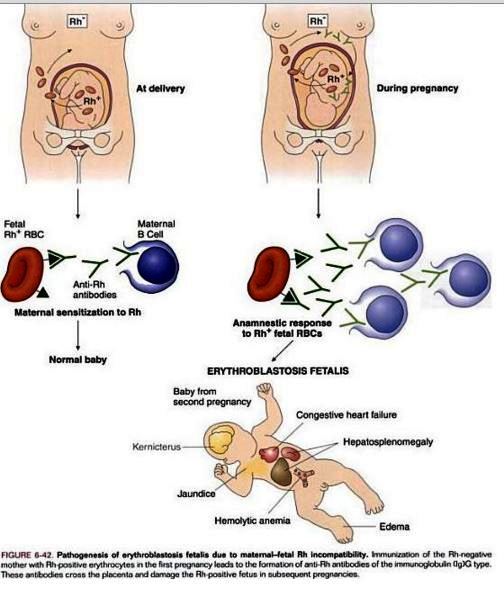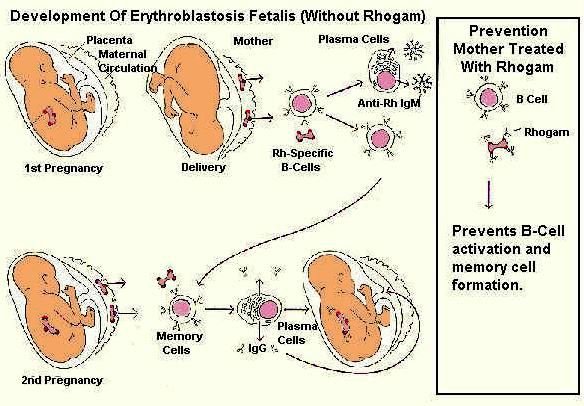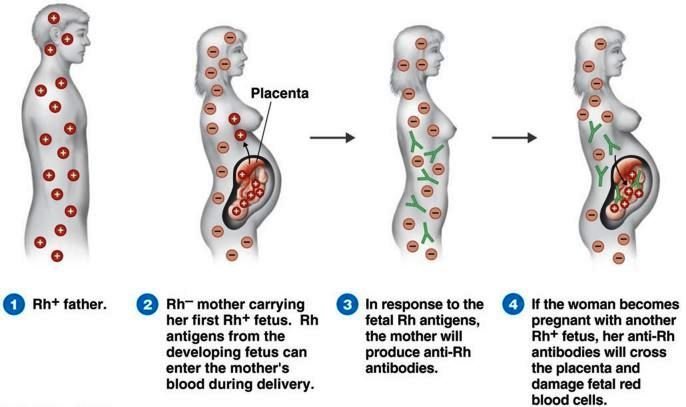Rh Incompatibility
Definition
Rh incompatibility is a medical condition that arise during the time of a woman’s pregnancy, where the woman has been identified to have an Rh-negative blood and the baby that she carries in her womb is known to have an Rh-positive blood. An Rh factor does not affect a person’s general health condition, although it can present some problems to the woman in her pregnancy.
By Rh-positive and Rh-negative, it simply means that your blood contains an Rh factor, which is a significant protein found on red blood cells. This Rh factor is inherited genetically from the parents and passed on to their children through the specific genes they carry. The presence of an Rh factor gives an Rh-positive result, whereas the absence of an Rh factor gives an Rh-negative result.
Symptoms of Rh Incompatibility
The clinical symptoms of an Rh incompatibility can be from a mild form to its most severe deadly form for the life of an unborn baby.
Hemolytic disease can happen when the mother’s antibodies will take into effect to attack the red blood cells (RBCs) of the newborn; thus once the RBCs of the newborn are being destroyed, it will lead to rising level of bilirubin in the newborn’s body and an excessive amount of this can impair the normal functioning of the liver by destroying newborn RBCs.
With too much bilirubin level, babies can manifest the following signs:
- Yellowish color/jaundice of the skin and the white portion of the eyes
- Lethargy is noted
- Low muscle tone is observed
The symptoms can only subside when a full treatment for Rh incompatiblity has been done.
Causes
The most known cause of an Rh incompatibility is the exposure of an Rh-negative mother with an Rh-positive baby at the time of pregnancy or delivery. During pregnancy, the baby’s blood can cross into a mother’s bloodstream especially upon delivery.
This is the time when you are Rh-negative and the baby is Rh-positive, that a reaction can occur when the body reacts to the baby’s blood as a foreign substance. The body will create antibodies made up of proteins to go against the baby’s Rh-positive blood, where a sensitization then happens.

Image 1

Image 2

Image 3

Image 1 to 4 Shows pathogenesis of rh incompatibility
There are two main mechanisms of an RH incompatibility:
- The most common type is an Rh-negative pregnant woman being exposed with Rh- positive fetal RBCs secondary to a case of fetomaternal hemorrhage during pregnancy as a result of abortion or any type of trauma
- When an Rh negative woman is receiving an Rh- positive blood transfusion
Possible causes that might lead for an Rh-negative pregnant woman to develop Rh incompatibilty are the following:
- Placenta previa
- Abruptio placenta
- Ectopic pregnancy
- Trauma to the abdomen or pelvis
- Intrauterine fetal death
- Experience of spontaneous abortion
- Lack of prenatal care during pregnancy
Diagnosis
Rh blood typing is always required in every pregnancy of a woman.
Tests for Rh-negative pregnant women:
- Rosette screening test to detect presence of an alloimmunization due to a fetomatenal hemorrhage
- Kleihauer-Betke test for quantitative measurement of fetal RBCs in maternal blood
- Indirect Coombs test for the woman to screen for IgG antibodies
- Point-of-care blood tests to determine Rh status
- Obtaining maternal Rh antibody titers as basis for future follow-up care
Tests for the newborn:
- Amniocentesis or Cordocentesis be done to evaluate fetal status in cases of Rh sensitization
- Direct Coombs test is done to confirm an existing immune mediated hemolytic anemia of the fetus or neonate
- Complete blood count to check hemoglobin level of the newborn with its platelet count
- Total and indirect bilirubin level of the newborn
Treatment
The treatment goal is directed at preventing the effects of an Rh incompatibility among women of the reproductive age.
Antenatal approach:
- Ultrasound and Doppler examinations to detect signs of fetal anemia and check for presence of hydrops fetalis
- Quantitative analysis of maternal anti-RhD antibodies since an increasing level means an existing fetal Rh problem
- Intrauterine blood transfusion
- Early delivery of the woman mostly after about the 36 weeks age of gestation
Postnatal approach:
- Phototherapy to resolve neonatal jaundice in mild cases
- Exchange transfusion in moderate to severe cases of the fetal problem
As general prevention, physicians give a series of two Rh immune-globulin shots during the first pregnancy when a woman is at risk to have Rh incompatibility in the future. The first shot is on the 28th week of pregnancy; then the second is given after delivery, within 72 hour-period.
Complications
Rh incompatibility rarely causes some complications during the first pregnancy of a woman. However, in cases where Rh antibodies are formed, it can be a fetal risk for future pregnancies.
References:
https://www.nhlbi.nih.gov/health/health-topics/topics/rh
http://emedicine.medscape.com/article/797150-clinical
http://www.healthline.com/health/rh-incompatibility#Treatment5
Thorp JM (2008 Feb). Utilization of anti-RhD in the emergency department after blunt trauma. Obstet Gynecol Surv. 63(2):112-5.
Cardo L, Garcia BP, Alvarez FV (2010 Aug). Non-invasive fetal RHD genotyping in the first trimester of pregnancy. Clin Chem Lab Med. 48(8):1121-6.
Elalfy MS, Elbarbary NS, Abaza HW (2011 Apr). Early intravenous immunoglobin (two-dose regimen) in the management of severe Rh hemolytic disease of newborn–a prospective randomized controlled trial. Eur J Pediatr. 170(4):461-7.
